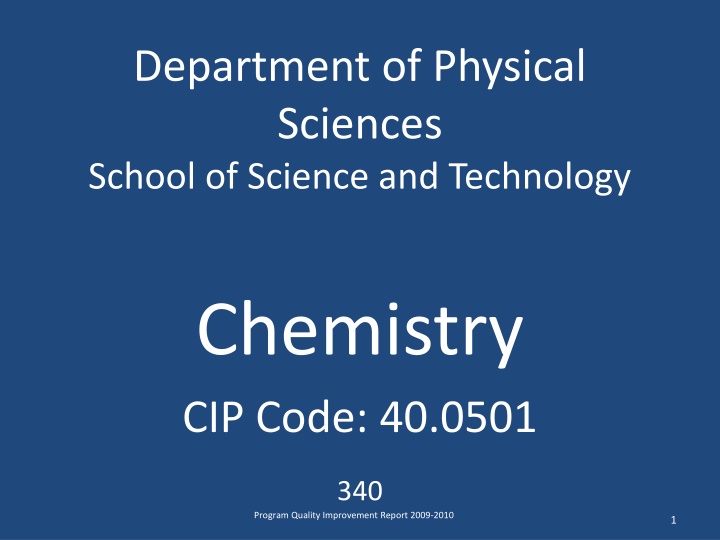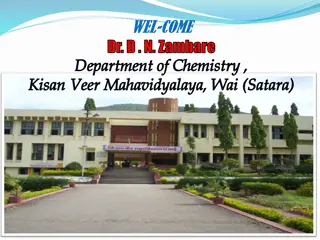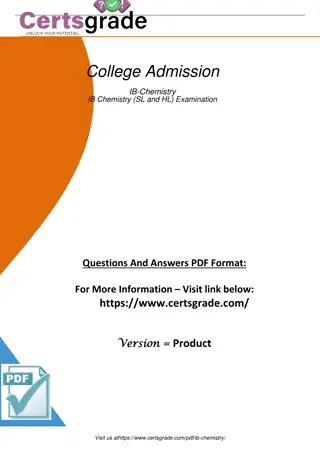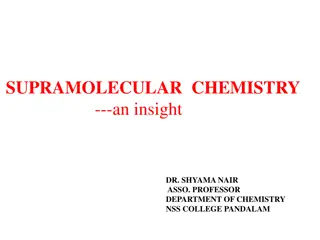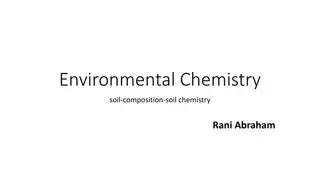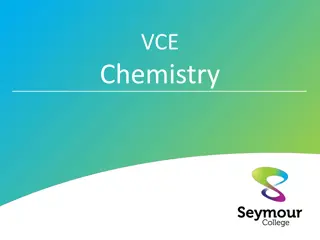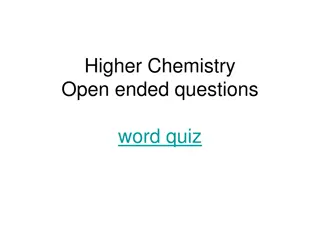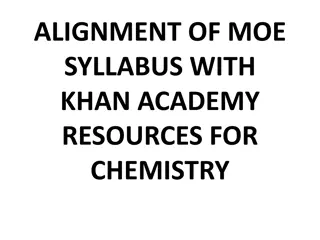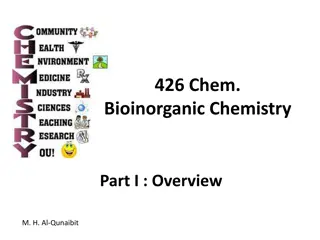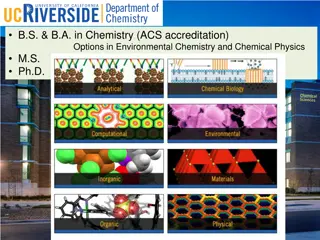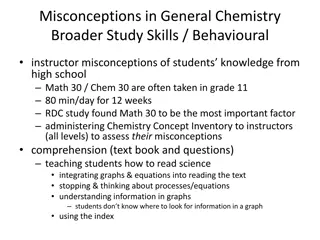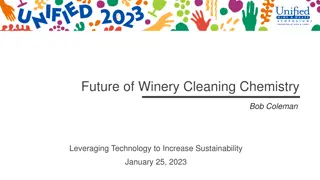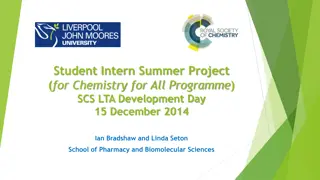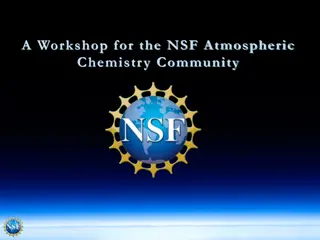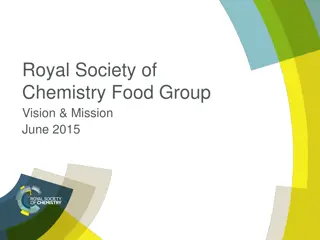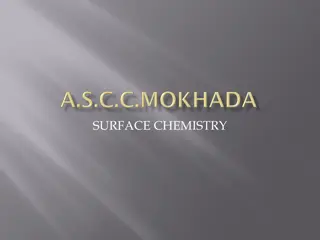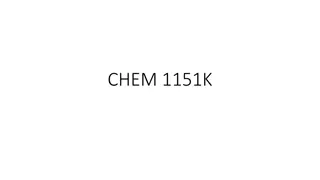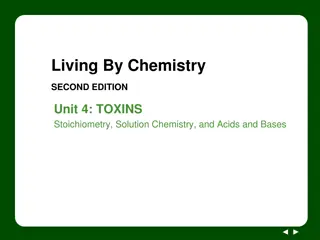Chemistry Program Quality Report
This report outlines the assessment of student learning outcomes in a Chemistry program, including topics such as stoichiometry, thermodynamics, atomic structure, bonding theories, solution concentrations, and more. The report discusses various areas where students are evaluated and provides insights into the program's quality improvement efforts.
Download Presentation

Please find below an Image/Link to download the presentation.
The content on the website is provided AS IS for your information and personal use only. It may not be sold, licensed, or shared on other websites without obtaining consent from the author.If you encounter any issues during the download, it is possible that the publisher has removed the file from their server.
You are allowed to download the files provided on this website for personal or commercial use, subject to the condition that they are used lawfully. All files are the property of their respective owners.
The content on the website is provided AS IS for your information and personal use only. It may not be sold, licensed, or shared on other websites without obtaining consent from the author.
E N D
Presentation Transcript
Department of Physical Sciences School of Science and Technology Chemistry CIP Code: 40.0501 340 Program Quality Improvement Report 2009-2010 1
Program actions since last assessment presentation 1. Student learning assessed by Major Field Achievement Test (MFAT) performance. Student learning assessed by ACS standardized test scores . Students performance data in first-semester ACS test analyzed and reviewed. Students assessed from their presentations in the capstone course, Literature for Physics and Chemistry, PSCI 4442. 2. 3. 4. Program Quality Improvement Report 2009-2010 2
Student Learning Outcomes Verbs from Bloom s Taxonomy (New Version) are given in the parentheses 1. Work with metric system using scientific measurements (remember, understand, and apply). 2. Write formulas for compounds, draw structures from names and derive names from structures of chemicals of inorganic or organic chemical origin (understand and apply). 3. Calculate basic stoichiometric values from equations involving solids, liquids, gases, and solutions (apply and analyze). 4. Apply thermodynamic principles to chemical systems, i.e., predicting directions of reactions, spontaneity of reactions, equilibrium constants, etc. (apply, analyze, and evaluate). 5. Understand atomic structures and be able to predict electronic structure based upon atomic position in periodic chart (understand, analyze, and evaluate) Program Quality Improvement Report 2009-2010
Learning Outcomes, Contd. 6. Predict/distinguish physical and chemical properties of elements based upon position in the periodic chart (analyze and evaluate). 7. Work with bonding theories to predict structure, geometry, polarities, hybridization (understand, apply, evaluate, and create). 8. Express solution concentrations in standard and nonstandard units, interconvert units, and apply stoichiometric principles (apply and analyze). 9. Interpret colligative properties (understand and apply). 10. Predict physical properties of matter based upon student understanding of intermolecular forces (apply, evaluate and create). 11. Predict qualitative properties of acids and bases in a variety of solvents (analyze, evaluate, and create). Program Quality Improvement Report 2009-2010 4
Learning Outcomes, Contd. 12. Work quantitatively with equilibrium systems as related to acid/base chemistry, solubility, electrochemistry, formation constants, and body processes (apply, analyze, and evaluate). 13. Manipulate rate equations of varying orders. Solve for dependent variables and relate these data to reaction mechanisms and physical results (apply, analyze, evaluate, and create). 14. Predict cell potentials of electrochemical cells and the relationship to solution thermodynamics, stoichiometry, and equilibrium systems (apply, analyze, and evaluate). 15. Predict and quantify the relationship of pressure, volume, mass, and temperatures of gases (apply and analyze). 16. Write/predict nuclear decay products and associated units of measurement (apply, analyze, and evaluate). Program Quality Improvement Report 2009-2010 5
Learning Outcomes, Contd. 17. Interpret and predict molecular and atomic behavior as measured by spectrometers of general use in a qualitative and/or quantitative manner (analyze, evaluate, and create). 18. Apply separation methods to analytical problems both qualitatively and quantitatively (apply, analyze, and evaluate). 19. Manipulate and interpret laboratory data numerically and graphically (apply, analyze, and evaluate). 20. Integrate the scientific literature with the knowledge base and learned skills of the program to function as an independent learner (analyze, evaluate, and create). 21. Apply principles of chemistry to processes and phenomena in living organisms (apply and analyze). 22. Get trained in independent research work (apply, analyze, evaluate, and create). Program Quality Improvement Report 2009-2010 6
Alignment of Learning Outcomes Connectivity matrix for areas of chemistry, individual courses, and learning outcomes Chemistry areas/courses Learning outcomes 11 12 13 1 2 3 4 5 6 7 8 9 10 14 15 16 17 18 19 20 21 22 Analytical: Fund. Analyt. Chem, 2113 Qual. Analysis, 2222 Quant. Analysis, 2232 Instrument. Methods, 4024 Inorganic: Gen Chem I, 1364/1361 Gen Chem II, 1474/1471 Adv. Inorg. Chem, 4334/4332 Adv. Gen. Chem. 4453 Organic: Org. Chem. I, 3314 Org. Chem. II, 3324 Org. Analysis, 3343 Organic Chem. 3345 Physical: Phys. Chem I, 4353/4351 Phys. Chem II, 4363/4361 Biochemistry: Biochem. I, 4403/4401 Biochem II, 4413/4411 Basic Biochem. 3544 Phys. Chem Lit., 4442 Sp. Prob. in Chem, 4491-4 Program Quality Improvement Report 2009-2010 7
Alignment of Outcomes Alignment with Cameron University Mission: Foster a student-centered academic environment that combines innovative classroom teaching with experiential learning . Prepare students for professional success, responsible citizenship, life-long learning, and meaningful contributions to a rapidly changing world . Alignment with School of Science and Technology Mission Educate students based on excellence in academic work and exposure to latest technological advances . Provide students the skills and confidence to excel as lifelong learners . Ensure success of graduates in a diverse and ever-changing environment . 8
Alignment of Outcomes Alignment with Physical Sciences Department Mission Provide a rigorous basic education in chemistry and physics both in theory and practice at various levels appropriate for students to prepare to become professionals in their selected fields of study as a major in chemistry Provide an education in chemistry and physics appropriate for students preparing for various careers, e.g., teaching science in secondary schools and health care. Relationship with Cameron University Plan 2013 (Goal One): Highest quality in instruction, research, and service to better meet the needs of the citizens of the region. Effective assessment of student learning . University and programmatic accreditation. Efficient, effective course delivery in multiple formats. Student/faculty opportunities to demonstrate scholarship in regional and national forums. 9
Measures of Learning Outcomes 1. Direct Measures Student GPA Student performance in MFAT exams in chemistry sub-areas Student performance in ACS standardized exams 2. Indirect Measures Chemistry graduate profiles 10 Program Quality Improvement Report 2009-2010
Student-learning outcome and measurements (MFAT Exams) MEASUREMENTS OF STUDENT LEARNING OUTCOME Methods used to determine validity of measurement instruments Methods used to determine reliability of measurements CURRICULUM AREA OR TARGET AUDIENCE PROGRAM OUTCOME Schedule for measurements Measurements Student performance (scores) in MFAT exams Upper division chemistry courses and general chemistry courses. Number of students (graduates): 6 MFAT tests from ETS in analytical, physical, inorganic, and organic chemistry Norm-referenced scores ETS data Annually in Spring Semester. Graduates give MFAT in their final year. 11 11 Program Quality Improvement Report 2009-2010
2009-2010 MFAT Scores MFAT raw score (%tile) Phys .Chem. Chem. 42(30) 40(30) 60(70) 31(5) 36(15) 40(30) 30(5) 40(30) 56(65) 49(50) 30(5) 37(25) 42.3(30) 39.5(30) Student ID # MFAT total (%tile) 142(35) 146(45) 136(20) 134(15) 152(60) 128(5) 139.7(30) Org. Inorg. Chem. 31(5) 45(40) 34(10) 42(30) 42(30) 34(10) 38.0(20) Anal. Chem. #1 #2 #3c #4 #5 #6 39(30) 56(70) 41(30) 36(15) 62(75) 25(1) 43.2(40) Institutional average (%tile) National mean (%tile) 147.9(50) 48.3(45) 47.6(50) 47.9(50) 47.4(45) Program Quality Improvement Report 2009-2010 12
Comparison of 2010 graduates MFAT composite scores, Chemistry GPA, and hours taken 2010 graduates MFAT composite score vs. Chemistry GPA Trends in chemistry graduates MFAT composite scores over 2002-2010 Trends in chemistry graduates MFAT scores in analytical chemistry over 2002-2010 13
Trends in chemistry graduates MFAT scores in inorganic chemistry over 2002-2010 Trends in chemistry graduates MFAT scores in organic chemistry over 2002-2010 Trends in chemistry graduates MFAT scores in MFAT assessment indicators: biochemistry and critical reasoning/thinking over 2006-2010 Trends in chemistry graduates MFAT scores in physical chemistry over 2002-2010 14
Student-learning outcome and measurements American Chemical Society (ACS) Standardized Tests MEASUREMENTS OF STUDENT LEARNING OUTCOME Methods used to determine validity of measurement instruments Methods used to determine reliability of measurements CURRICULUM AREA OR TARGET AUDIENCE PROGRAM OUTCOME Schedule for measurements Measurements Student performance (scores) standardized American Chemical Society (ACS) tests General, organic, inorganic, physical, analytical and biochemistry courses Number of students (graduates): 6 Recent versions of tests developed by ACS Norm-referenced scores National norm data from ACS Tests given as finals at the end of major chemistry courses. 15 15 Program Quality Improvement Report 2009-2010
2009-2010 Graduates American Chemical Society (ACS) Standardized Test Scores Student ID # Gen. Chem. (%tile) (%tile) (%tile) Inorg. Chem. Org. Chem. Phys. Chem. (%tile) Phys. Chem. (Thermo.) (%tile) 50 18(12) 26(50) 41(98) 28.3(61) Biochem. (%tile) Analyt. Chem. (%tile) Instrum. Methods (%tile) Max. points #1 #2 #3c #4 #5 #6 Institutional average (%tile) National mean (%tile) aStudent #3 took the course at a different institution no score was available. 70 60 70 20(5) 28(21) 22(8) 22(8) 39(50) 26.2(16) 60 60 50 60 - 31(39) 51(89) a 30(35) 39(64) 37(58) 37.6(61) 28(34) 32(52) 44(92) 34.7(65) 26(44) 36(87) 23(29) 25(30) 30(57) 23(29) 27.2(49) 23(27) 23(27) 36(63) 30(35) 26(20) 31(38) 30.8(38) 30(39) 30(39) 35.5(51) 28.4(49) 39.2(50) 32.0(52) 26.4(50) 32.9(53) 27.5(50) 32.8(48) 16
Student-learning outcome and measurements (First-Semester General Chemistry ACS Tests) MEASUREMENTS OF STUDENT LEARNING OUTCOME Methods used to determine validity of measurement instruments Methods used to determine reliability of measurements CURRICULUM AREA OR TARGET AUDIENCE PROGRAM OUTCOME Schedule for measurements Measurements Student performance (scores) in first- semester General Chemistry ACS tests First-semester general chemistry course (Chem 1364) Number of students: - 92 for analysis on all topics. - 350 for specific analysis on stoichiometry topic. Standardized tests from ACS in general chemistry (first-semester) Norm-referenced scores ACS data As final at the end of Chem 1364 course. For several years, also given for pre- course baseline determination. 17 17 Program Quality Improvement Report 2009-2010
Topic-specific performance analysis of first-semester ACS general chemistry exam. A: Formulas and nomenclature. B: Matter and measurement. C: Oxidation state. D: Percentage composition/formula #students: 92 Topic-specific performance analysis of first-semester ACS general chemistry exam. A: Types of reactions and equation. B: Mole concepts. C: Stoichiometry. #students: 92 18 Topic-specific performance analysis of first-semester ACS general chemistry exam. A: Periodic table and periodicity of properties. Topic-specific performance analysis of first-semester ACS general chemistry exam. A: Gas laws. B: Thermochemistry.
Comparison of students performance (average) on stoichiometry questions in first-semester ACS general chemistry exam given at the beginning and the end of a semester (pre-course and post-course, respectively) Number of students: 350 19
Summary Except in a few cases, MFAT and ACS test scores of graduates trail national average. Graduates MFAT performance in organic and inorganic chemistry on the decline MFAT performance improved in physical and analytical chemistry MFAT assessment indicator in biochemistry - on the decline Performance of CU students in first-semester ACS General Chemistry I test: Better than national average on certain topics, e.g., atomic structure and molecular structure/ bonding. trails the national average on stoichiometry, gas laws, and thermochemistry. 20 20 Program Quality Improvement Report 2009-2010
Action plan for Student-Learning Outcomes Analyze and evaluate the performance of the past students in the standardized ACS tests in organic chemistry and biochemistry and thus identify the key areas (topics) in which the students have displayed weakness. The technique of teaching of these topics will be revised to specifically raise the learning level of future students in the identified areas. Timeline: Spring, 2011 Fall, 2013. Programmatic efforts directed toward improving the performance of future graduates in MFAT tests: - Develop multiple-choice MFAT-standard practice exams of MFAT all sub-areas. - Require the would-be graduates to complete the practice exams. - To provide incentive, decide the grade in the Chem Lit course in part by whether these practice assignments (homework) have been completed by the students. Timeline: Spring, 2011 - A multi-step approach to improve the learning of chemistry in the General Chemistry I course (Chem 1364): - Put emphasis on the topics identified as weak from recent student performance analysis. - Scrutinize the preparedness of the students who enroll in this course . - Strictly enforce the requirement of having taken the college algebra course or taking it concurrently and/or having taken an appropriate chemistry course previously. - Develop a separate General Chemistry course for pre-nursing and related students Time line: Spring, 2011 - 1. 2. 3. 21
Ancillary Actions Continue utilization of the computer lab as a learning tool and for instructional purposes. In addition to computational chemistry experiments added to the Chem I lab manual (using ScigressTM), higher-level experiments using Gaussian (e.g., for electronic structure calculations) and SybylTM (e.g., for protein modeling) will be included in Physical Chemistry and Biochemistry courses. Continue online homework (via MasteringChemistry) and prelab assignment (via Blackboard). Such electronic methodologies are proving to be effective tools for learning. Consciously, coordinate and orient the lab experiments with the lecture courses to improve learning through hands-on work (experiential learning). Popularize research to the upper-class students and encourage them to join on- and off-campus research programs. Encourage students to participate actively in the Graduate Awareness day activities and thus be aware of opportunities for graduate studies, summer research, and industrial employments. 22
Published information on graduates Academic Year 09-10Entered Graduate Working In Discipline Other School 0 0 1 Summer 2009 Fall 2009 Spring 2010 0 1 1 0 1 2 Total 1 2 3 23 Program Quality Improvement Report 2009-2010
